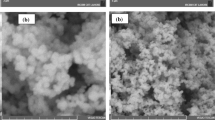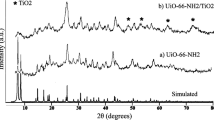Abstract
The photodegradation and mineralization efficiency (technical evaluation) and process economics (economic evaluation) are important in selection of a particular type of TiO2 for large-scale commercial applications involving heterogeneous photocatalysis. In this paper, techno-economic evaluation of indigenous anatase TiO2 (ana-TiO2) and aeroxide p25 TiO2 (p25-TiO2) photocatalyst for heterogeneous photocatalysis of basic yellow 28 (BY28) dye solution is studied. The characterization of photocatalysts was done through X-ray diffraction, Tauc’s plot, and point of zero charge. The important parameters related to heterogeneous photocatalytic process like photocatalyst loading, UV intensity, and A/V (area-to-volume) ratio were studied and optimized as per ability of photocatalyst for the full utilization of light illumination. BY28 dye degradation depicted pseudo-first-order kinetics under UV radiations and solar light. Electric energy per order and collector area per order was also evaluated for the two systems. Finally, economic evaluation of these two types of TiO2 was done in terms of total material and energy cost involved for 90% removal of BY28 dye from 1 m3 solution under UV radiations and solar light. Ana-TiO2 found to be more economical than p25-TiO2 in terms of operating cost involved for photocatalytic degradation of BY28 dye. Alternatively, photocatalytic unit using p25-TiO2 showed higher treatment capacity as compared to ana-TiO2 due to higher photodegradation and mineralization efficiency of the former. Finally, a method for selection of particular type of TiO2 (p25-TiO2 or ana-TiO2) for a photocatalytic unit is suggested by considering volumetric capacity of photocatlytic unit, volume of effluent generated per day by the dyeing unit, photodegradation efficiency of TiO2, and process economics. This study would be useful for the decision making authorities in profitable selection of particular type of TiO2 for treating given volume of effluent.











Similar content being viewed by others
References
Adesina, A. A. (2004). Industrial exploitation of photocatalysis: Progress, perspectives and prospects. Catalysis Surveys from Asia,8, 265–273.
Ajmal, A., Majeed, I., Malik, R. N., Idriss, H., & Nadeem, M. A. (2014). Principles and mechanisms of photocatalytic dye degradation on TiO2 based photocatalysts: a comparative overview. RSC Advances,4, 37003–37026.
Allen, N. S., Edge, M., Verran, J., Stratton, J., Maltby, J., & Bygott, C. (2008). Photocatalytic titania based surfaces: Environmental benefits. Polymer Degradation and Stability,93, 1632–1646.
Bandala, E. R., & Estrada, C. (2007). Comparison of solar collection geometries for application to photocatalytic degradation of organic contaminants. Journal of Solar Energy Engineering,129, 22–26.
Bansal, P., & Sud, D. (2011). Photodegradation of commercial dye, procion blue HERD from real textile wastewater using nanocatalysts. Desalination,267, 244–249.
Bessekhouad, Y., Robert, D., Weber, J. V., & Chaoui, N. (2004). Effect of alkaline-doped TiO2 on photocatalytic efficiency. Journal of Photochemistry and Photobiology A: Chemistry,67, 49–57.
Bolton, J. R., Bircher, K. G., Tumas, W., & Tolman, C. A. (2001). Figures-of-merit for the technical development and application of advanced oxidation technologies for both electric- and solar-driven systems. Pure and Applied Chemistry,73, 627–637.
Bouchy, M., & Zahra, O. (2003). Photocatalytic reactors. International Journal of Photoenegy,5, 191–197.
Calza, P., Medana, C., Pazzi, M., Baiocchi, C., & Pelizzetti, E. (2004). Photocatalytic transformations of sulphonamides on titanium dioxide. Applied Catalysis, B: Environmental,53, 63–69.
Chacon, J. M., Leal, M. T., Sanchez, M., & Bandala, E. R. (2006). Solar photocatalytic degradation of azo-dyes by photo-Fenton process. Dyes and Pigments,69, 144–150.
Chawla, P., Sharma, S. K., & Toor, A. P. (2013). Modified titanium dioxide nanomaterials for the enhancement of heterogeneous photocatalysis. In R. C. Sobti, A. Kaushik, B. Singh, & S. K. Tripathi (Eds.), Emerging paradigm in nanotechnology (pp. 338–346). New Delhi: Pearson.
Chong, M. N., Jina, B., Zhud, H. Y., Chow, C. W. K., & Saint, C. (2009). Application of H-titanate nanofibers for degradation of Congo Red in an annular slurry photoreactor. Chemical Engineering Journal,150, 49–54.
Gaya, U. I., & Abdullah, A. H. (2008). Heterogeneous photocatalytic degradation of organic contaminants over titanium dioxide: A review of fundamentals, progress and problems. Journal of Photochemistry and Photobiology C: Photochemistry Reviews,9, 1–12.
Grzechulska-Damszel, J., Tomaszewska, M., & Morawski, A. W. (2009). Integration of photocatalysis with membrane processes for purification of water contaminated with organic dyes. Desalination,241, 118–126.
Gupta, S. M., & Tripathi, M. (2011). A review of TiO2 nanoparticles. Chinese Science Bulletin,56, 1639–1657.
Holmberg, J. P., Ahlberg, E., Bergenholtz, J., Hassellov, M., & Abbas, Z. (2013). Surface charge and interfacial potential of titanium dioxide nanoparticles: Experimental and theoretical investigations. Journal of Colloid and Interface Science,407(1), 168–176.
Huang, M., Xu, C., Wu, Z., Huang, Y., Lin, J., & Wu, J. (2008). Photocatalytic discolorization of methyl orange solution by Pt modified TiO2 loaded on natural zeolite. Dyes and Pigments,77, 327–334.
Jiang, P., Ren, D., He, D., Fu, W., Wang, J., & Gu, M. (2014). An easily sedimentable and effective TiO2 photocatalyst for removal of dyes in water. Separation and Purification Technology,122, 128–132.
Kaur, J., & Singhal, S. (2014). Heterogeneous photocatalytic degradation of rose bengal: Effect of operational parameters. Physica B: Condensed Matter,450, 49–53.
Kaur, T., Toor, A. P., & Wanchoo, R. K. (2015). Parametric study on degradation of fungicide carbendazim in dilute aqueous solutions using nano TiO2. Desalination and Water Treatment,54, 122–131.
Kositzi, M., Poulios, I., Samara, K., Tsatsaroni, E., & Darakas, E. (2007). Photocatalytic oxidation of cibacron yellow LS-R. Journal of Hazardous Materials,146, 680–685.
Liang, Y., Zhou, B., Li, N., Liu, L., Xu, Z., Li, F., et al. (2018). Enhanced dye photocatalysis and recycling abilities of semi-wrapped TiO2@carbon nanofibers formed via foaming agent driving. Ceramics International,44(2), 1711–1718.
Liao, D. L., & Liao, B. Q. (2007). Shape, size and photocatalytic activity control of TiO2 nanoparticles with surfactants. Journal of Photochemistry and Photobiology A: Chemistry,187, 363–369.
Nagaraja, R., Kottam, N., Girija, C. R., & Nagabhushana, B. M. (2012). Photocatalytic degradation of Rhodamine B dye under UV/solar light using ZnO nanopowder synthesized by solution combustion route. Powder Technology,215–216, 91–97.
Natarajan, T. S., Thomas, M., Natarajan, K., Bajaj, H. C., & Tayade, R. J. (2011). Study on UV-LED/TiO2 process for degradation of Rhodamine B dye. Chemical Engineering Journal,169, 126–134.
Nawaz, M. S., & Ahsan, M. (2014). Comparison of physico-chemical, advanced oxidation and biological techniques for the textile wastewater treatment. Alexandria Engineering Journal,53, 717–722.
Neppolian, B., Choi, H. C., Sakthivel, S., Arabindoo, B., & Murugesan, V. (2002). Solar light induced and TiO2 assisted degradation of textile dye reactive blue 4. Chemosphere,46, 1173–1181.
Oller, I., Malato, S., & Sanchez-Perez, J. A. (2011). Combination of advanced oxidation processes and biological treatments for wastewater decontamination—A review. Science of the Total Environment,409, 4141–4166.
Paola, A. D., GarcıaLopez, E., Ikeda, S., Marc, G., Ohtani, B., & Palmisano, L. (2002). Photocatalytic degradation of organic compounds in aqueous systems by transition metal doped polycrystalline TiO2. Catalysis Today,75, 87–93.
Paola, A. D., GarcıaLopez, E., Marc, G., & Palmisano, L. (2012). A survey of photocatalytic materials for environmental remediation. Journal of Hazardous Materials,211–212, 3–29.
Rajeshwar, K., Osugi, M. E., Chanmanee, W., Chenthamarakshan, C. R., Zanoni, M. V. B., Kajitvichyanukul, P., et al. (2008). Review heterogeneous photocatalytic treatment of organic dyes in air and aqueous media. Journal of Photochemistry and Photobiology C: Photochemistry Reviews,9, 171–192.
Rengaraj, S., & Li, X. Z. (2006). Enhanced photocatalytic activity of TiO2 by doping with Ag for degradation of 2,4,6-trichlorophenol in aqueous suspension. Journal of Molecular Catalysis A: Chemical,243, 60–67.
Saepurahman, A. M. A., & Chong, F. K. (2010). Preparation and characterization of tungsten-loaded titanium dioxide photocatalyst for enhanced dye degradation. Journal of Hazardous Materials,76, 451–458.
Salehi, M., Hashemipour, H., & Mirzaee, M. (2012). Experimental study of influencing factors and kinetics in catalytic removal of methylene blue with TiO2 nanopowder. American Journal of Environmental Engineering,2(1), 1–7.
Sarwan, B., Pare, B., Acharya, A. D., & Jonnalagadda, S. B. (2012). Mineralization and toxicity reduction of textile dye neutral red in aqueous phase using BiOCl photocatalysis. Journal of Photochemistry and Photobiology B: Biology,116, 48–55.
Scanlon, D. O., Dunnill, C. W., Buckeridge, J., Shevlin, S. A., Logsdail, A. J., Woodley, S. M., et al. (2013). Band alignment of rutile and anatase TiO2. Nature Materials,12, 798–801.
Sraw, A., Wanchoo, R. K., & Toor, A. P. (2014). Optimization and kinetic studies for degradation of insecticide monocrotophos using LR grade and P25 TiO2 under UV/sunlight conditions. Environmental Progress and Sustainable Energy,33, 1201–1208.
Tariq, M. A., Faisal, M., Saquib, M., & Muneer, M. (2008). Heterogeneous photocatalytic degradation of an anthraquinone and a triphenylmethane dye derivative in aqueous suspensions of semiconductor. Dyes and Pigments,76, 358–365.
Teh, C. M., & Mohamed, A. R. (2011). Roles of titanium dioxide and ion-doped titanium dioxide on photocatalytic degradation of organic pollutants (phenolic compounds and dyes) in aqueous solutions: A review. Journal of Alloys and Compounds,509, 1648–1660.
Toor, A. P., Verma, A., Jotshi, C. K., Bajpai, P. K., & Singh, V. (2006). Photocatalytic degradation of direct yellow 12 dye using UV/TiO2 in a shallow pond slurry reactor. Dyes and Pigments,68, 53–60.
Toor, A. P., Yadav, N., & Wanchoo, R. K. (2013). Enhancement in photocatalytic activity of nano TiO2 photocatalyst by carbon doping. Material Science Forum,757, 271–284.
Tumuluri, A., Naidu, L. K., & Raju, K. C. J. (2014). Band gap determination using Tauc’s plot for LiNbO3 thin films. International Journal of ChemTech Research,6, 3353–3356.
Venkatachalam, N., Palanichamy, M., Arabindoo, B., & Murugesan, V. (2007). Enhanced photocatalytic degradation of 4-chlorophenol by Zr4+ doped nano TiO2. Journal of Molecular Catalysis A: Chemical,266, 158–165.
Zangeneh, H., Zinatizadeh, A. A. L., Habibi, M., Akia, M., & Isa, M. H. (2015). Photocatalytic oxidation of organic dyes and pollutants in wastewater using different modified titanium dioxides: A comparative review. Journal of Industrial and Engineering Chemistry,26, 1–36.
Zubieta, C. E., Messina, P. V., & Schulz, P. C. (2012). Photocatalytic degradation of acridine dyes using anatase and rutile TiO2. Journal of Environmental Management,101, 1–6.
Acknowledgements
The facilities provided by Energy Research Centre (ERC) for carrying out the research work are duly acknowledged. We also acknowledge DST-PURSE and TEQIP-II grant in providing chemicals and analysis. The support of Central Instrumentation Laboratory (CIL), Punjab University, for providing instrument facilities is highly acknowledged. The authors are extremely grateful to dyeing unit of Vardhman Spinning and General Mills, Ludhiana, for providing the sample of dye (basic yellow 28).
Author information
Authors and Affiliations
Corresponding author
Rights and permissions
About this article
Cite this article
Chawla, P., Sharma, S.K. & Toor, A.P. Techno-economic evaluation of anatase and p25 TiO2 for treatment basic yellow 28 dye solution through heterogeneous photocatalysis. Environ Dev Sustain 22, 231–249 (2020). https://doi.org/10.1007/s10668-018-0194-z
Received:
Accepted:
Published:
Issue Date:
DOI: https://doi.org/10.1007/s10668-018-0194-z




